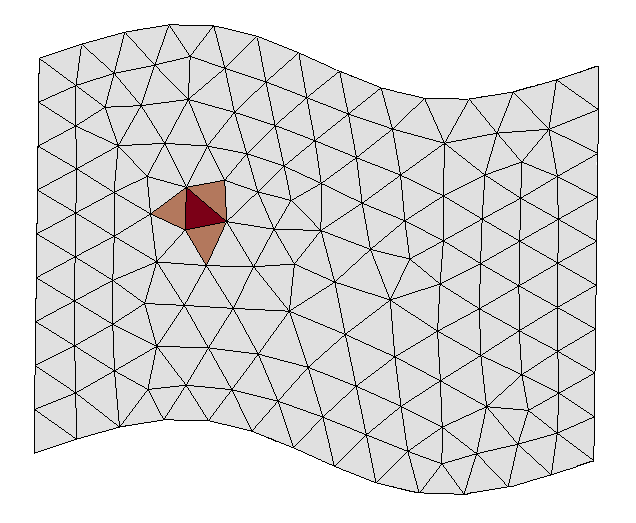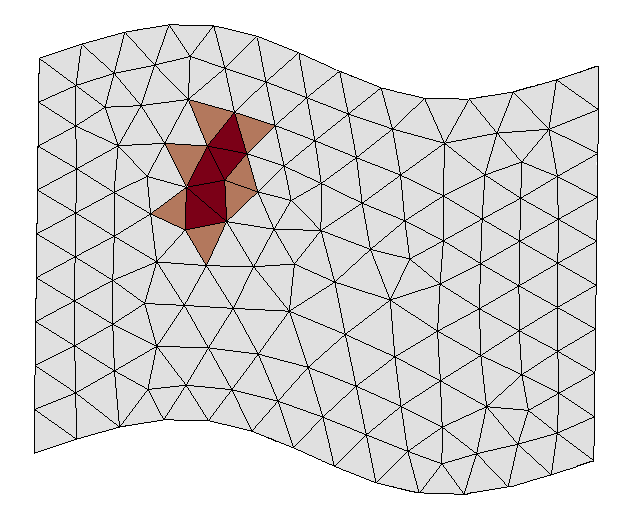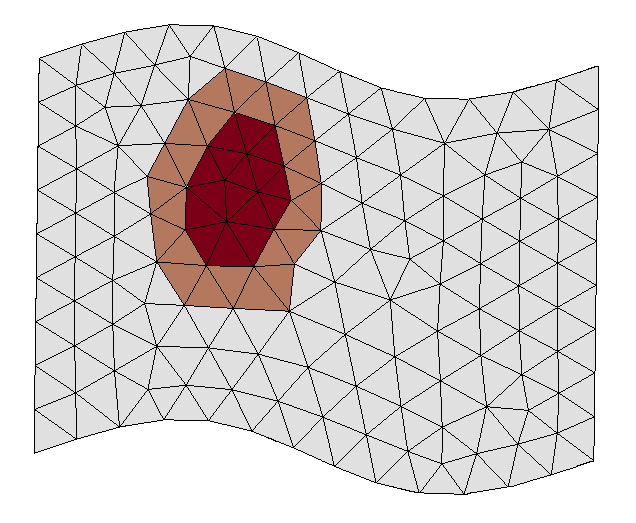- variableThe variable(s) for which to find connected regions of interests, i.e. "features".
C++ Type:std::vector<VariableName>
Unit:(no unit assumed)
Controllable:No
Description:The variable(s) for which to find connected regions of interests, i.e. "features".
FeatureFloodCount
The FeatureFloodCount object is a utility that inspects solution fields looking for Connected Components or "topologically connected regions of a solution field sharing a similar characteristic". Typically, this means a region where the solution value is higher than some threshold. This object is designed to work efficiently on a partitioned unstructured mesh with hundreds to thousands of processors.

Figure 1: The identification of a new feature.

Figure 2: Intermediate stage of identification.

Figure 3: Identification of the region complete.

Figure 4: Halo extension complete.
<br/> The algorithm for identifying portions of connected components begins by running a Flood Fill algorithm on each processor that recursively visits neighboring elements on the unstructured mesh while the connecting criteria is met. Figure 1 illustrates the identification of a new region on a processor. The dark shaded element represents an element that was identified whose variable value exceeds a given threshold. The lightly shaded elements surrounding the dark element represent the current "halo" markings of the region. These halo markings always extend one neighbor beyond the currently shaded region. They are used for both the connected component algorithm and for identifying potential collisions among disjoint regions.

Figure 5: Regular grid with 6 features partitioned 3 ways.

Figure 6: Global identification of all features.
<br/> Several pieces of information are recorded on each processor including all of the marked elements, a minimum ID for a partition independent stable ordering and "overlapping elements" for stitching. Figure 5 shows a regular mesh partitioned among three processors with several regions of interest. The alpha characters represent a possible local ordering of the features. The subscript represents the processor ID. Portions of the feature data structure is serialized and sent to the rank 0 process where connection information is used to discover the global picture Figure 6.
The object is able to find and count "connected components" in any solution field or number of solution fields. A primary example would be to count "bubbles".
Input Parameters
- boundaryThe list of boundaries (ids or names) from the mesh where this object applies
C++ Type:std::vector<BoundaryName>
Controllable:No
Description:The list of boundaries (ids or names) from the mesh where this object applies
- compute_halo_mapsFalseInstruct the Postprocessor to communicate proper halo information to all ranks
Default:False
C++ Type:bool
Controllable:No
Description:Instruct the Postprocessor to communicate proper halo information to all ranks
- compute_var_to_feature_mapFalseInstruct the Postprocessor to compute the active vars to features map
Default:False
C++ Type:bool
Controllable:No
Description:Instruct the Postprocessor to compute the active vars to features map
- connecting_thresholdThe threshold for which an existing feature may be extended (defaults to "threshold")
C++ Type:double
Unit:(no unit assumed)
Controllable:No
Description:The threshold for which an existing feature may be extended (defaults to "threshold")
- enable_var_coloringFalseInstruct the Postprocessor to populate the variable index map.
Default:False
C++ Type:bool
Controllable:No
Description:Instruct the Postprocessor to populate the variable index map.
- flood_entity_typeELEMENTALDetermines whether the flood algorithm runs on nodes or elements
Default:ELEMENTAL
C++ Type:MooseEnum
Controllable:No
Description:Determines whether the flood algorithm runs on nodes or elements
- secondary_percolation_boundariesPaired boundaries with "primaryary_percolation_boundaries" parameter
C++ Type:std::vector<BoundaryName>
Controllable:No
Description:Paired boundaries with "primaryary_percolation_boundaries" parameter
- specified_boundariesAn optional list of boundaries; if supplied, each feature is checked to determine whether it intersects any of the specified boundaries in this list.
C++ Type:std::vector<BoundaryName>
Controllable:No
Description:An optional list of boundaries; if supplied, each feature is checked to determine whether it intersects any of the specified boundaries in this list.
- threshold0.5The threshold value for which a new feature may be started
Default:0.5
C++ Type:double
Unit:(no unit assumed)
Controllable:No
Description:The threshold value for which a new feature may be started
- use_less_than_threshold_comparisonTrueControls whether features are defined to be less than or greater than the threshold value.
Default:True
C++ Type:bool
Controllable:No
Description:Controls whether features are defined to be less than or greater than the threshold value.
Optional Parameters
- allow_duplicate_execution_on_initialFalseIn the case where this UserObject is depended upon by an initial condition, allow it to be executed twice during the initial setup (once before the IC and again after mesh adaptivity (if applicable).
Default:False
C++ Type:bool
Controllable:No
Description:In the case where this UserObject is depended upon by an initial condition, allow it to be executed twice during the initial setup (once before the IC and again after mesh adaptivity (if applicable).
- execute_onTIMESTEP_ENDThe list of flag(s) indicating when this object should be executed. For a description of each flag, see https://mooseframework.inl.gov/source/interfaces/SetupInterface.html.
Default:TIMESTEP_END
C++ Type:ExecFlagEnum
Controllable:No
Description:The list of flag(s) indicating when this object should be executed. For a description of each flag, see https://mooseframework.inl.gov/source/interfaces/SetupInterface.html.
- execution_order_group0Execution order groups are executed in increasing order (e.g., the lowest number is executed first). Note that negative group numbers may be used to execute groups before the default (0) group. Please refer to the user object documentation for ordering of user object execution within a group.
Default:0
C++ Type:int
Controllable:No
Description:Execution order groups are executed in increasing order (e.g., the lowest number is executed first). Note that negative group numbers may be used to execute groups before the default (0) group. Please refer to the user object documentation for ordering of user object execution within a group.
- force_postauxFalseForces the UserObject to be executed in POSTAUX
Default:False
C++ Type:bool
Controllable:No
Description:Forces the UserObject to be executed in POSTAUX
- force_preauxFalseForces the UserObject to be executed in PREAUX
Default:False
C++ Type:bool
Controllable:No
Description:Forces the UserObject to be executed in PREAUX
- force_preicFalseForces the UserObject to be executed in PREIC during initial setup
Default:False
C++ Type:bool
Controllable:No
Description:Forces the UserObject to be executed in PREIC during initial setup
Execution Scheduling Parameters
- condense_map_infoFalseDetermines whether we condense all the node values when in multimap mode (default: false)
Default:False
C++ Type:bool
Controllable:No
Description:Determines whether we condense all the node values when in multimap mode (default: false)
- control_tagsAdds user-defined labels for accessing object parameters via control logic.
C++ Type:std::vector<std::string>
Controllable:No
Description:Adds user-defined labels for accessing object parameters via control logic.
- enableTrueSet the enabled status of the MooseObject.
Default:True
C++ Type:bool
Controllable:Yes
Description:Set the enabled status of the MooseObject.
- outputsVector of output names where you would like to restrict the output of variables(s) associated with this object
C++ Type:std::vector<OutputName>
Controllable:No
Description:Vector of output names where you would like to restrict the output of variables(s) associated with this object
- primary_percolation_boundariesA list of boundaries used in conjunction with the corresponding "secondary_percolation_boundaries" parameter for determining if a feature creates a path connecting any pair of boundaries
C++ Type:std::vector<BoundaryName>
Controllable:No
Description:A list of boundaries used in conjunction with the corresponding "secondary_percolation_boundaries" parameter for determining if a feature creates a path connecting any pair of boundaries
- use_displaced_meshFalseWhether or not this object should use the displaced mesh for computation. Note that in the case this is true but no displacements are provided in the Mesh block the undisplaced mesh will still be used.
Default:False
C++ Type:bool
Controllable:No
Description:Whether or not this object should use the displaced mesh for computation. Note that in the case this is true but no displacements are provided in the Mesh block the undisplaced mesh will still be used.
- use_global_numberingTrueDetermine whether or not global numbers are used to label features on multiple maps (default: true)
Default:True
C++ Type:bool
Controllable:No
Description:Determine whether or not global numbers are used to label features on multiple maps (default: true)
- use_single_mapTrueDetermine whether information is tracked per coupled variable or consolidated into one (default: true)
Default:True
C++ Type:bool
Controllable:No
Description:Determine whether information is tracked per coupled variable or consolidated into one (default: true)
Advanced Parameters
- prop_getter_suffixAn optional suffix parameter that can be appended to any attempt to retrieve/get material properties. The suffix will be prepended with a '_' character.
C++ Type:MaterialPropertyName
Unit:(no unit assumed)
Controllable:No
Description:An optional suffix parameter that can be appended to any attempt to retrieve/get material properties. The suffix will be prepended with a '_' character.
- use_interpolated_stateFalseFor the old and older state use projected material properties interpolated at the quadrature points. To set up projection use the ProjectedStatefulMaterialStorageAction.
Default:False
C++ Type:bool
Controllable:No
Description:For the old and older state use projected material properties interpolated at the quadrature points. To set up projection use the ProjectedStatefulMaterialStorageAction.